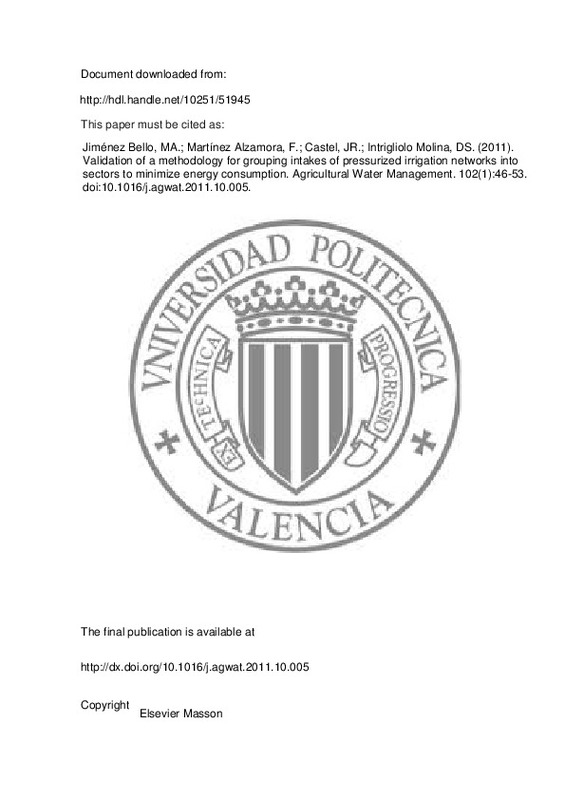JavaScript is disabled for your browser. Some features of this site may not work without it.
Buscar en RiuNet
Listar
Mi cuenta
Estadísticas
Ayuda RiuNet
Admin. UPV
Validation of a methodology for grouping intakes of pressurized irrigation networks into sectors to minimize energy consumption
Mostrar el registro sencillo del ítem
Ficheros en el ítem
| dc.contributor.author | Jiménez Bello, Miguel Ángel
|
es_ES |
| dc.contributor.author | Martínez Alzamora, Fernando
|
es_ES |
| dc.contributor.author | Castel, Juan Ramón
|
es_ES |
| dc.contributor.author | INTRIGLIOLO MOLINA, DIEGO SEBASTIANO
|
es_ES |
| dc.date.accessioned | 2015-06-19T09:24:31Z | |
| dc.date.available | 2015-06-19T09:24:31Z | |
| dc.date.issued | 2011-12-15 | |
| dc.identifier.issn | 0378-3774 | |
| dc.identifier.uri | http://hdl.handle.net/10251/51945 | |
| dc.description.abstract | A methodology to optimise the amount of energy consumed in pressurized irrigation systems was presented by Jimenez-Bello et al. (2010a). These authors proposed grouping pressurized irrigation network intakes, each of the water turnouts resulting from a shared hydrant, into sectors via a genetic algorithm. In the present research, the methodology was applied and validated in a water users association. Several energy efficiency indicators were calculated and compared during five consecutive seasons (2006-2010). The first two seasons, when the methodology was not employed, were used as reference for the results obtained from 2008 onwards, when the methodology was applied to the management of irrigation network. Results obtained in seasons 2008-2010 showed that the average energy savings were 16% in comparisons to the 2006 season. However, it should be noted that the potential, theoretical savings, could have been as high as 22.3% if the modelled grouping networks would have been accurately followed. There was in fact some discrepancy between the theoretical model outputs and the final groupings due to some intake restrictions. In addition, during the irrigation campaigns, the number of irrigation intakes that operated within each sector was not always equal to the modelled sectoring, a fact that reduced the overall water users association energy efficiency. This occurred particularly during rainy periods, when some users deliberately decided to close their manual irrigation intakes valves. Overall, results showed the potential of the validated methodology for optimising energy use. However, the final overall system efficiency might depend on specific constraints that need to be taken into account when attempting to use model output predictions. | es_ES |
| dc.description.sponsorship | This research was supported by funds from Interreg IV SUDOEB project "Telerieg" and from MICIIN project Rideco CSD2006-0067. The authors would like to thank the Company Tecnicas Valencianas del Agua (TECVASA) and the IMPIVA institute for their support in this research study. | en_EN |
| dc.language | Inglés | es_ES |
| dc.publisher | Elsevier Masson | es_ES |
| dc.relation.ispartof | Agricultural Water Management | es_ES |
| dc.rights | Reserva de todos los derechos | es_ES |
| dc.subject | Energy optimisation | es_ES |
| dc.subject | Irrigation networks | es_ES |
| dc.subject | Irrigation scheduling | es_ES |
| dc.subject | Network sectoring | es_ES |
| dc.subject | Agriculture | es_ES |
| dc.subject | Water Resources | es_ES |
| dc.subject | Water | es_ES |
| dc.subject | Optimization | es_ES |
| dc.subject | Efficiency | es_ES |
| dc.subject.classification | INGENIERIA HIDRAULICA | es_ES |
| dc.title | Validation of a methodology for grouping intakes of pressurized irrigation networks into sectors to minimize energy consumption | es_ES |
| dc.type | Artículo | es_ES |
| dc.identifier.doi | 10.1016/j.agwat.2011.10.005 | |
| dc.relation.projectID | info:eu-repo/grantAgreement/MEC//CSD2006-00067/ES/Programa integral de ahorro y mejora en la productividad del agua de riego en la horticultura española/ | es_ES |
| dc.rights.accessRights | Abierto | es_ES |
| dc.contributor.affiliation | Universitat Politècnica de València. Departamento de Ingeniería Hidráulica y Medio Ambiente - Departament d'Enginyeria Hidràulica i Medi Ambient | es_ES |
| dc.description.bibliographicCitation | Jiménez Bello, MÁ.; Martínez Alzamora, F.; Castel, JR.; Intrigliolo Molina, DS. (2011). Validation of a methodology for grouping intakes of pressurized irrigation networks into sectors to minimize energy consumption. Agricultural Water Management. 102(1):46-53. https://doi.org/10.1016/j.agwat.2011.10.005 | es_ES |
| dc.description.accrualMethod | S | es_ES |
| dc.relation.publisherversion | http://dx.doi.org/10.1016/j.agwat.2011.10.005 | es_ES |
| dc.description.upvformatpinicio | 46 | es_ES |
| dc.description.upvformatpfin | 53 | es_ES |
| dc.type.version | info:eu-repo/semantics/publishedVersion | es_ES |
| dc.description.volume | 102 | es_ES |
| dc.description.issue | 1 | es_ES |
| dc.relation.senia | 233128 | |
| dc.contributor.funder | Técnicas Valencianas del Agua S.A. | es_ES |
| dc.contributor.funder | Ministerio de Educación y Ciencia | es_ES |
| dc.contributor.funder | Instituto de la Pequeña y Mediana Industria de la Generalitat Valenciana | es_ES |
| dc.contributor.funder | Interreg | es_ES |







![[Cerrado]](/themes/UPV/images/candado.png)

